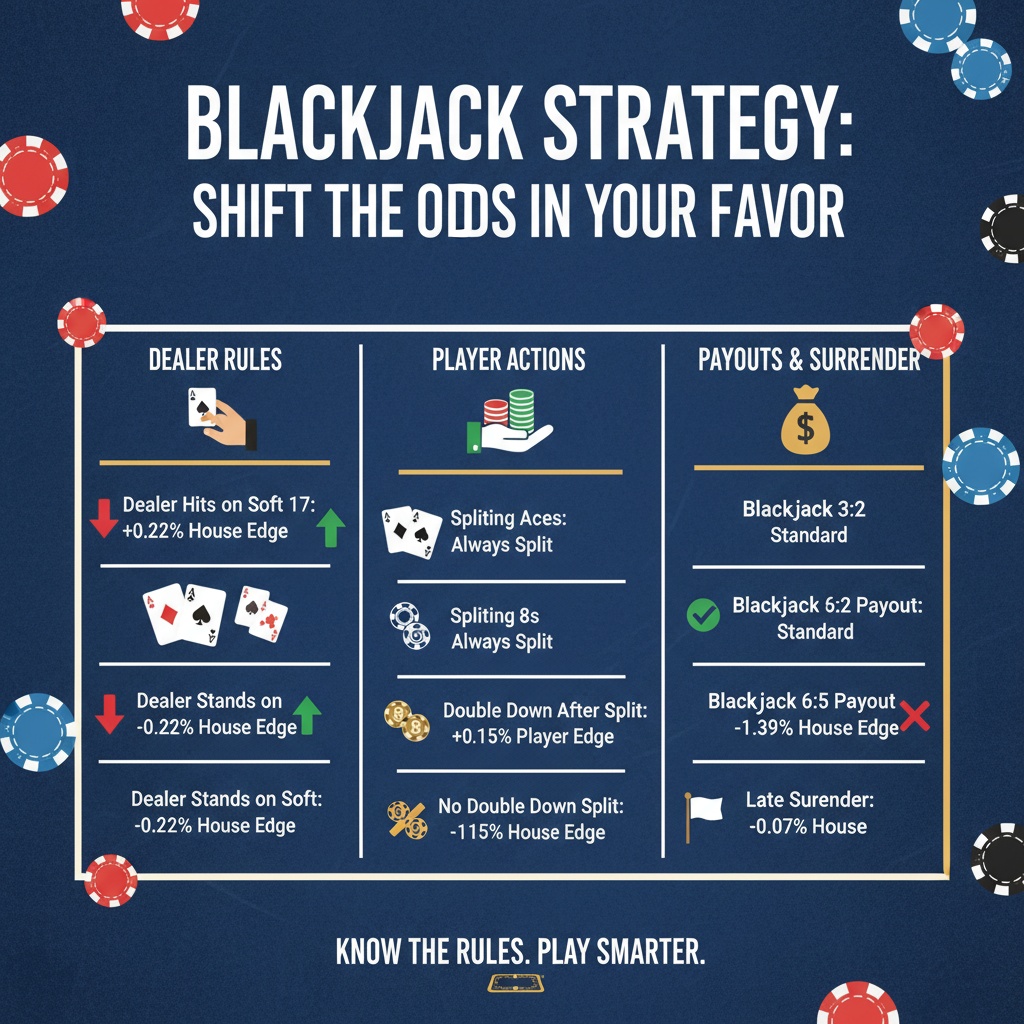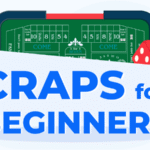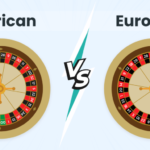
Blackjack Rules That Change the Odds
Spot the best tables in seconds—and know exactly what each rule does to the math.
Last updated: September 3, 2025 · Guide Math‑honest
Quick Rule Effects (Cheat Sheet)
Effects shown are typical changes to player expected return, assuming basic strategy and a standard eight‑deck baseline.
| Rule | Effect on player return | Why it matters |
|---|---|---|
| Blackjack pays 3:2 vs 6:5 | 6:5 worsens edge by ~1.39% | Biggest single gotcha on many floors. Prefer 3:2 tables. |
| Dealer on Soft 17 | S17 is better; H17 costs ~0.22% | H17 lets the dealer improve many A‑x hands; you’ll push/win less. |
| Deck count | Fewer decks help: single‑deck ≈ +0.48% vs 8‑deck | All else equal, 1–2 decks are friendlier—watch out for 6:5 traps. |
| DAS (Double After Split) | Not allowing DAS costs ≈ 0.14% | Post‑split doubles (e.g., splitting 8s then doubling 11) add EV. |
| Late Surrender (LS) | Worth ≈ +0.08% overall | Saving half a bet on the worst matchups trims long‑run losses. |
TL;DR: Hunt 3:2, S17, DAS, LS, with the fewest decks you can find.
How to Read the Felt & Signage
The 10‑second scan
- Does the felt say BLACKJACK PAYS 3 TO 2? If not: move on.
- Check placard for S17 vs H17.
- Look for DAS and SURRENDER on the rules plaque.
- Ask the dealer: “How many decks? Do you allow late surrender?”
Watch for marketing traps
- Single‑deck that pays 6:5 is often worse than 6–8 deck 3:2.
- ETGs/video “blackjack” may use H17 and short pays—always read info screens.
- Side bets often carry big edges; treat them as entertainment, not value.
Common Rule Packages: Best vs Worst
Player‑Friendly (seek these)
- 3:2 payout, S17, DAS, LS, 2–6 decks
- Clear signage; no obscure “push 22” or 6:5 variants
Predatory (avoid if possible)
- 6:5 payout (or worse), H17, no DAS, no surrender
- Rule packages like “dealer 22 pushes” or tie‑loses variants
Las Vegas trend watch: some casinos increased 3:2 tables in 2025; still verify every table—policies vary by pit and time.
Worked Examples: What It Costs Per Hour
Illustration for a casual player betting $25/hand at ~60 hands/hour:
- Solid 3:2 S17 DAS LS game with basic strategy: total edge can be ≈ 0.3–0.5% → expected loss ≈ $4.50–$7.50/hour.
- Same table but H17: add ≈ 0.22% → +$3.30/hour.
- Change to 6:5: add ≈ 1.39% → +$20.85/hour (now ≈ $25–$30/hr total).
These are illustrative. Real results vary with pace, side bets, tips, and mistakes. The direction is what matters: small rule changes compound into big hourly differences.
Mini‑FAQ
Is single‑deck always better?
No. Single‑deck helps the math, but casinos often pair it with 6:5 or H17, which more than cancel the benefit. Always weigh the full package.
Should I chase tables just for Late Surrender?
It’s a small edge saver (≈ 0.08%), but useful for disciplined players who apply it correctly against strong dealer upcards (e.g., 16 vs 9/10/A in multi‑deck).
Quick order of importance?
1) 3:2 payout → 2) S17 → 3) DAS → 4) Decks → 5) Late Surrender.
Original Bullets (Preserved)
We keep the exact original wording below for transparency.
- 3:2 vs 6:5 blackjack payout: 6:5 is significantly worse—avoid where possible.
- Dealer stands on soft 17 (S17) vs hits (H17): standing is better for players.
- Decks: fewer decks are generally better, all else equal.
- DAS (double after split) and late surrender (LS): small but meaningful improvements.
Tip: scan felt signage before you sit, or ask the dealer to confirm rules.
References (Authoritative & Global)
- Math & Rules: Wizard of Odds — House‑edge basics & rule effects; H17 vs S17; deck counts; surrender; DAS; calculator.
- Regulatory & RG: UK Gambling Commission (UK), NCPG/GRA (Singapore), DICJ (Macau, China SAR), ERAI (Russia), iGaming Ontario/AGCO (Canada).
- Market trend examples: Las Vegas Review‑Journal coverage of 3:2 expansions (Palms; The STRAT, 2025).
We review and refresh these links periodically. Always check your local laws and the specific table’s posted rules.






